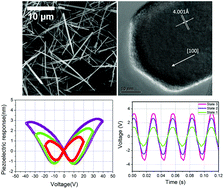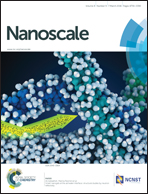Lead-free 0.5Ba(Zr0.2Ti0.8)O3–0.5(Ba0.7Ca0.3)TiO3 nanowires for energy harvesting
Abstract
Lead-free piezoelectric nanowires (NWs) show strong potential in sensing and energy harvesting applications due to their flexibility and ability to convert mechanical energy to electric energy. Currently, most lead-free piezoelectric NWs are produced through low yield synthesis methods and result in low electromechanical coupling, which limit their efficiency as energy harvesters. In order to alleviate these issues, a scalable method is developed to synthesize perovskite type 0.5Ba(Zr0.2Ti0.8)O3–0.5(Ba0.7Ca0.3)TiO3 (BZT–BCT) NWs with high piezoelectric coupling coefficient. The piezoelectric coupling coefficient of the BZT–BCT NWs is measured by a refined piezoresponse force microscopy (PFM) testing method and shows the highest reported coupling coefficient for lead-free piezoelectric nanowires of 90 ± 5 pm V−1. Flexible nanocomposites utilizing dispersed BZT–BCT NWs are fabricated to demonstrate an energy harvesting application with an open circuit voltage of up to 6.25 V and a power density of up to 2.25 μW cm−3. The high electromechanical coupling coefficient and high power density demonstrated with these lead-free NWs produced via a scalable synthesis method shows the potential for high performance NW-based devices.


 Please wait while we load your content...
Please wait while we load your content...